

Five Fabulous Favorite Fotos: Jerry Foss
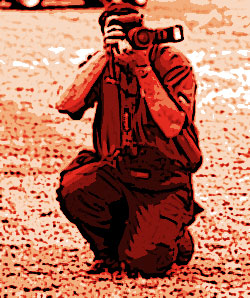 |
 |
Even though I'm known as a writer, I consider myself a pretty fair photographer as well. Self-taught in my pre-NHRA days with decent results, I found out when I got here that I really didn't know as much as I thought I did. Fortunately for me, there was Leslie Lovett, our late, great photo editor. He took me under his wing as we traveled from national event to national event, upgrading my equipment when he felt my skills warranted it. He used to kid me that, even though he was a photographer, he valued the importance of the writers because, after all, he needed their words to frame his photos.
I have the utmost respect for the job of the professional drag race photographer. I know that many of the images that grace the pages of National DRAGSTER, NHRA.com, and other publications and websites don’t just happen; they're not just snapshots where the people behind the lens just happened to point their cameras in the right direction and luckily fire the shutter at the right time. Just as my job as a writer requires that I be able to work with nouns and verbs and adjectives, it's not just about placing them in the correct by-the-books order. I need to make them come alive, to sing, to capture a moment or an emotion by manipulating a finite number of letters (that's 26, for those still learning the alphabet); so must the photographer manipulate his or her environment, making optimal use of the subject, the environment and its lighting conditions, and his or her equipment and savvy. A lot of planning, imagination, and creativity can go into the millisecond it takes to actually capture an image.
As promised a few entries ago, I will occasionally feature here some of the great works of the photographers who contribute to our publications. I've asked a number of them to submit to me their five favorite photos, along with a narrative of how they captured their moment. Asking any longtime photographer to choose just five images from the hundreds of thousands they may have taken is like asking me to choose my five favorite words – it ain't easy. But, hey, I'm the editor, right? So here we go.
Because this column is about and by the National DRAGSTER staff, it's only fair and right that I open the gallery with one of our own, Assistant Photo Editor Jerry Foss. Jerry's been working at ND since 1993 and before that worked in the photo lab of a portrait photographer, so he's well-schooled in the nuances of photography. Jerry is one of a tight-knit traveling DRAGSTER photo team that also includes Photo Editor Teresa Long, Marc Gewertz, Richard Wong, and Richard Brady. They'll shoot a combined 3,000 or so images at each event, only a small fraction of which will appear in National DRAGSTER. The rest will grace numerous other publications and brochures, hallways,conference rooms, offices, trade-show booths, and sponsorship presentations. Their work is invaluable to NHRA's publicity goals.
Here are Jerry's five favorite photos, in his own words.
| "Some of the most dramatic images in drag racing can only be captured at night, many of them with a long exposure. Because it is dark, everyone is shooting with a flash, which means that if you are using a long exposure (1/15 of a second or slower) and there is a high probability that you will get someone else's flash on your image along with your own. Such was the case last year in Atlanta. My solution was to turn my flash off; increase my exposure to 1/6 of a second, and hope to pick up someone else's flash, which resulted in this image of Gary Scelzi. The long exposure gives you the streaked lights and the foggy look to the race track, while the flash stops the motion of the car. You get an even better effect when the flash is coming from another direction than your camera, as is the case here." | 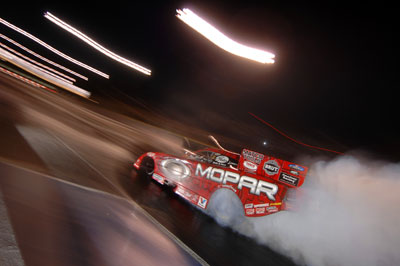 See bigger |
|
|
|
| "The O'Reilly Spring Nationals in Houston last year was a very emotional race for everyone as it was the first race following the death of Eric Medlen. Ron Capps, in particular was very emotional after his win. When he was done with his TV interview, he walked away from the cameras to be alone for moment. I followed him at a distance hoping to capture an image that showed the emotion of the day. After walking 20 or so feet away, he stopped and stood just as you see him here, with no one watching but me. Well, I'm sure Eric was watching. too." | 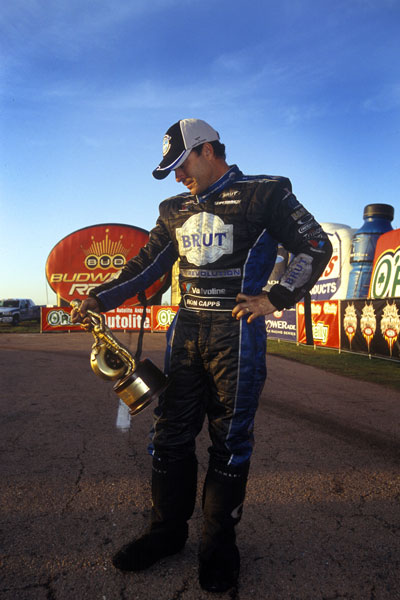 See bigger |
|
|
|
| "This image is from the 2000 Budweiser Top Fuel Shootout which was finished at the 2001 Winternationals. The sun was setting and casting a beautiful golden light. I moved off to the side to get a different angle than everyone else was shooting. As I moved to the side, the sun reflecting off of the black background created the golden color you see here. This combined with the joy on the faces of Gary Scelzi and Alan Johnson makes this one of my favorites." | 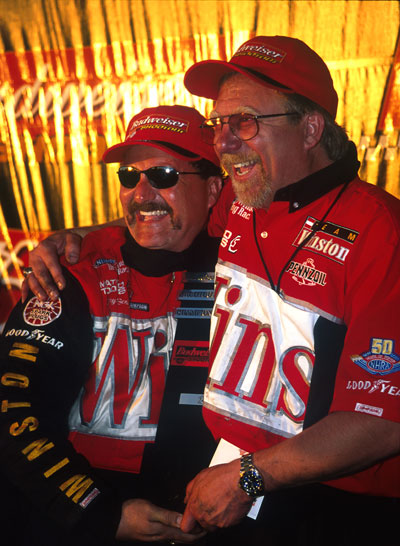 See bigger |
|
|
|
| "During Friday Night qualifying at the 2001 US Nationals, Darrell Gwynn made a pass down the IRP dragstrip (his first since his 1990 accident) in a hand-controlled electric-powered dragster. Knowing that we would have plenty of images of his car from our other photographers, I wanted to get something different that would capture the many emotions of the moment. I positioned myself so I could get a photo of the car and still get a photo of his parents, Jerry and Joan, and the team with the famous Indy tower in the background. It was an emotional moment for all, and one I'll not soon forget." |  See bigger |
|
|
|
| "Some years ago I purchased a large flash unit to use at the races. At Indy in 2003 I used it with a remote transmitter so I could place the flash close to where I wanted to car to be when I shot the photo. I was about 225 feet down track with a 300mm lens. This enabled me to shoot further down track than I normally would at night, with a slower shutter speed (for bigger flames), and still have the car in focus since the flash would stop the motion of the car. Larry Dixon helped out a great deal with a spectacular launch with the front end a foot off the ground." | 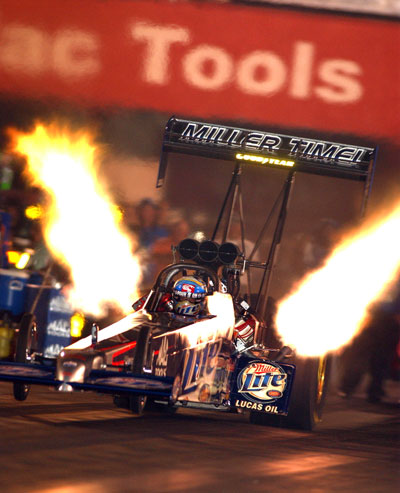 See bigger |



















































